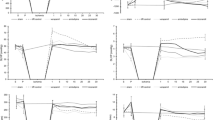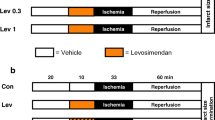Abstract
The effect of preconditioning (PC) on acute ischemic myocardial injury was investigated in an openchest dog model. Preconditioned dogs received four 5-min occlusions of the left anterior descending coronary artery (LAD), each separated by 10 min of reperfusion. Four groups were used to assess the effect: non-PC group (G-1), PC group (G-2), 8-phenyltheophylline-(adenosine receptor blocker) infused PC group (G-3), and nicorandil- (ATP-sensitive K-channel opener) infused PC group (G-4). The LAD was occluded for 60 min, followed by 60 min of reperfusion in all dogs. The rate of ultrastructural myocardial severe injury was 26% in G-1, 0% in G-2, 5% in G-3, and 0% in G-4. Biochemical analayses also indicated higher values of myocardial contractile function in G-2 and G-4 than G-1 and G-3. These data suggest that the adenosine receptor and K channel may play a key role in PC.
Similar content being viewed by others
References
Murry CE, Jennings RB, Reimer KA (1986) Preconditioning with ischemia: a delay of lethal cell injury in ischemic myocardium. Circulation 75:1124–1136
Li GC, Vasquez JA, Gallagher KP, Lucchesi BR (1990) Myocardial protection with preconditioning. Circulation 82:609–619
Hoffmeister HM, Mauser M, Schaper W (1986) Repeated short periods of regional myocardial ischemia: effect on local function and high energy phosphate levels. Basic Res Cardiol 81:361–372
Gross GJ, Auchampach JA (1992) Blockade of ATP-sensitive potassium channels prevents myocardial preconditioning in dogs. Circ Res 70:223–233
Kitakaze M, Hori M, Takashima S, Sato H, Inoue M, Kamada T (1993) Ischemic preconditioning increases adenosine release and 5′-nucleotidase activity during myocardial ischemia and reperfusion in dogs: implication for myocardial salvage. Circulation 87:208–215
Yellon DM, Alkhulaifi AM, Browne EE, Pugsley WB (1992) Ischemic preconditioning limits infarct size in the rat heart. Cardiovasc Res 26:983–987
Cohen MV, Liu GS, Downey JM (1991) Preconditioning causes improved wall motion as well as smaller infarcts after transient coronary occlusion in rabbits. Circulation 84:341
Liu GS, Thornton J, Van Winkle DM, Stanley AWH, Olsson RA, Downey JM (1991) Protection against infarction afforded by preconditioning is mediated by A1-adenosine receptors in the rabbit heart. Circulation 84:350–356
Schott RJ, Rohmann S, Braun ER, Schaper W (1990) Ischemic preconditioning reduces infarct size in swine myocardium. Circ Res 66:1133–1142
Deutsch E, Berger M, Kussmaul WG, Hirshfeld JW, Herrmann HG, Laskey WK (1990) Adaptation to ischemia during percutaneous transluminal coronary angioplasty: clinical, hemodynamic, and metabolic features. Circulation 82:2044–2051
Yellon, DM, Alkhulaifi AM, Pugsley WB (1993) Preconditioning the human myocardium. Lancet 342:276–277
Kloner RA, Shook T, Przyklenk K, Davis VG, Cannon CP, McCabe CH, Braunwald E (1995) Previous angina alters inhospital outcome in TIMI 4: a Clinical correlate to preconditioning? Circulation 91:37–47
Murry CE, Richard VJ, Reimer KA, Jennings RB (1990) Ischemic preconditioning slows energy metabolism and delays ultrastructural damage during a sustained ischemic episode. Circ Res 66:913–931
Fox KAA, Saffitz JE, Corr PB (1987) Pathogenesis of myocardial reperfusion. Cardiol Clin 5:31–48
Virmani R, Forman MB, Kolodgie FD (1990) Myocardial reperfusion injury: histopathological effects of perfluorochemical. Circulation 81(suppl IV):57–68
Kloner RA, Ganote CE, Whalen DA, Jennings RB (1974) Effect of a transient period of ischemia on myocardial cells. II. Fine structure during the first few minutes of reflow. Am J Pathol 74:399–421
Kloner RA, Braunwald E (1980) Observations on experimental myocardial ischemia. Cardiovasc Res 14:371–395
Jennings RB, Ganote CE (1974) Structural changes in myocardium during acute ischemia. Circ Res 34, 35(suppl III):III-156–III-168
Ozawa K, Takeyama Y, Katagiri T (1982) Electron microscopic studies on the ATPase activity in myocardial infarction. Jpn Circ J 46:725–733
Konno N, Yanagishita T, Geshi E, Katagiri T (1987) Degradation of the cardiac sarcoplasmic reticulum in acute myocardial ischemia. Jpn Circ J 51:411–420
Laemmli UK (1970) Cleavage of structural proteins during the assembly of the head of bacteriophage T. Nature 227:680–685
Toba K, Katagiri T, Takeyama Y (1978) Studies on the cardiac sarcoplasmic reticulum in myocardial infarction. Jpn Circ J 42:447–453
Nakae I, Hashimoto K, Morigami N, Nakagawa M, Nakamura Y, Mitsunami K, Kinoshota M (1992) Mechanisms of action of nicorandil on coronary artery in dogs. Ther Res 13:1766
Nakae I, Quan L, Hashimoto K, Sugimoto Y, Tsutamoto Y, Kinoshota M (1994) Mechanism of the vasodilatory action of nicorandil on coronary circulation in dogs. Cardiovasc Drugs Ther 8:137–145
Hashimoto K, Kinoshota M, Ohbayashi Y (1991) Coronary effect of nicorandil in comparsion with nitroglycerin in chronic conscious dogs. Cardiovasc Drugs Ther 5:131–138
Geshi E, Konno N, Ito S, Mukae S, Suwa Y, Hiroshige J, Hasegawa S, Umetsu K, Mochizuki T, Kitsu T, Yanagishita T, Tanno F, Yaida M, Sekita S, Katagiri T (1989) Pharmacological intervention of acute ischemic myocardial injury. J Mol Cell Cardiol Suppl 21:S139
Hearse DJ (1995) Activation of ATP-sensitive potassium channels: a novel pharmacological approch to myocardial protection? Cardiovasc Res 30:1–17
Nakae I, Quan L, Sugimoto Y, Tsutamoto Y, Kinoshota M (1994) Glibenclamide-induced oscillation of canine coronary artery is independent of myocardial ischemia. J Cardiovasc Pharmacol 23:473–479
George CL, Juan AV, Kim PG, Benedict RL (1995) Myocardial protection with preconditionung. Circulation 82:609–619
Menasche P, Kevelaitis E, Mouas C, Grousset C, Piwnica A, Bloch G (1995) Preconditioning with potassium channel openers. J Cardiovasc Surg 110:1606–1613
Hagar JM, Hale SL, Kloner RA (1991) Effect of preconditioning ischemia on reperfusion arrhythmias after coronary artery occlusion and reperfusion in the rat. Circ Res 68:61–68
Vegh A, Komori S, Szekeres L, Parratt JR (1992) Antiarrhythmic effects of preconditioning in anesthetised dogs and rats. Cardiovasc Res 26:487–495
Tan HL, Mazon P, Verberne HJ, Sleeswijk, ME, Coronel R, Opthof T, Janse MJ (1993) Ischemic preconditioning delays ischema-induced cellular electrical uncoupling in rabbit myocardium by activation of ATP-sensitive potassium channels. Cardiovasc Res 27:644–651
Author information
Authors and Affiliations
Rights and permissions
About this article
Cite this article
Nakatani, M., Ishioka, H., Koba, S. et al. Ultrastructural and biochemical studies of ischemic preconditioning using an adenosine receptor blocker and an ATP-sensitive K channel opener. Med Electron Microsc 30, 63–69 (1997). https://doi.org/10.1007/BF01545083
Received:
Accepted:
Issue Date:
DOI: https://doi.org/10.1007/BF01545083




